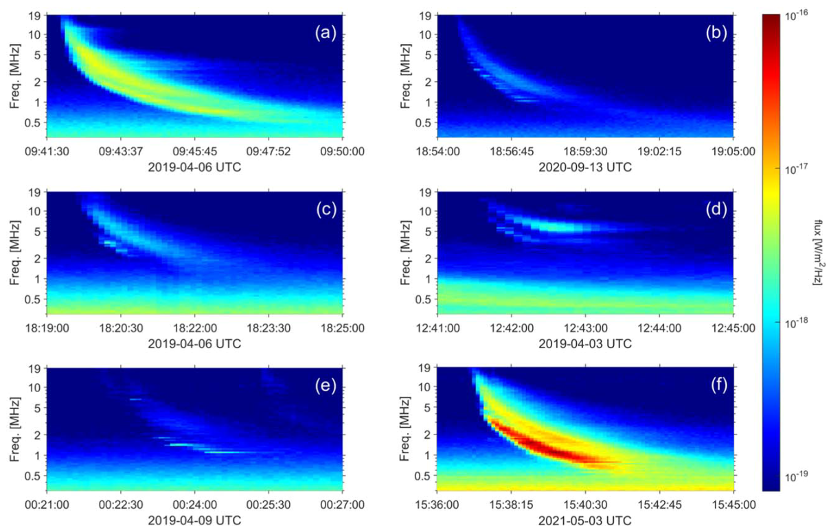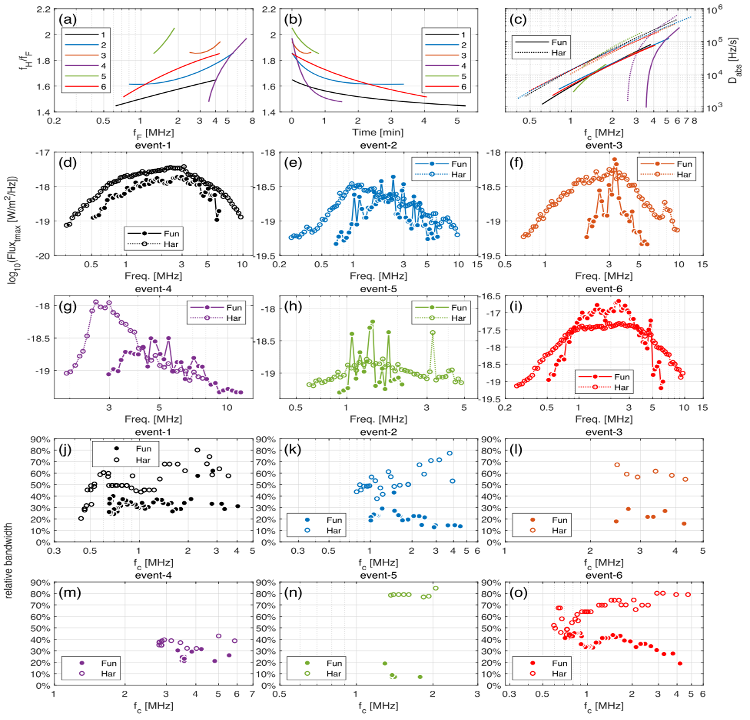Type III radio bursts are the most powerful and common type of solar radio bursts, shifting rapidly from high to low frequencies. In addition to the fast frequency drift from high to low frequencies, the fundamental–harmonic (F-H) frequency pairs’ structure in their dynamic spectra is the other most important observed feature of solar type III radio bursts. In this Letter, using the radio data observed by PSP during encounter phases from the first orbit to the ninth orbit (E01-E09) with 7 s (E01-E05) and the enhanced 3.5 s (E06-E09) temporal resolutions, we report the representative spectral characteristics of F-H pairs of IP type III radio bursts. These spectral characteristics can provide some constraints of their source regions and will be helpful for us to understand the physics of their formation.
Observation and Data Analysis
On the basis of the frequency-drift rate, the F-H pairs of IP type III radio bursts can be divided into two categories, that is, the quasi-parallel F-H pairs with quasi-parallel F and H frequency-drift rate curves (see, e.g., Figure 2 (c)) and the nonparallel F-H pairs with nonparallel F and H frequency-drift rate curves, and the former is the dominating one.
Comparing the spectral characteristics of these F and H pairs, such as the frequency-drift rate, emission intensity, relative bandwidth, duration, and fine structure, they may be divided into six typical types for the case of F-H pairs with quasi-parallel frequency-drift rate (Figure 1 and Figure 2). However, since the emission mechanism of radio bursts depends sensitively on the local plasma parameters in the source regions, the understanding of the physics that causes the difference in the spectral characteristics requires further detailed analysis. In the present study, we are just trying to provide some preliminary interpretations for the spectral characteristics based on the new electron cyclotron maser (ECM) emission mechanism that takes account of the effects of the ambient Alfvén waves (Wu et al. 2012, Wu 2014, Chen et al. 2017, Chen et al. 2021) as a potential physical model of the formation of them as follows:
- F being Shorter Duration than H: One of the possible reasons is that based on the ECM emission mechanism the F radiation is emitted at electron cyclotron frequency $f_{ce}$ of the local plasma, which possibly is very close to the electron plasma frequency $f_{pe}$, and F only emits when the $f_{ce}$ is higher than the $f_{pe}$, while H is not restricted by this limitation. That is, F is more susceptible to be cut off, which prevents it from continuing to radiate.
- F being Structured and H being Smooth: The X-mode emission in the F frequency band in general cannot escape due to the emission frequency lower than the X-mode cutoff frequency. Therefore, the F components of the F-H pairs are dominated by the O-mode emission, and the H components consist of the O-mode and X-mode emissions. In consequence, based on the new ECM emission model, the F components appear to have considerable striae because of a significant modulation of the O-mode growth rate deduced by Alfvén wave, while the H components have little striae due to little effect on the X-mode growth rate by the Alfvén
- Emission Intensity of H being Higher or Lower than F: Based on the new ECM emission model, the growth rates of the O1 (F wave in the O-mode), O2, and X2 (second H waves in the O- and X-modes) mode emissions, in different way, not only sensitively depend on the local parameters of the background plasma and the velocity distribution of the fast electron beams but also are considerably modulated by the intensity of the ambient Alfvén waves. This could be probably one of the main reasons that the relative intensity of the F and H components varies dependently on individual events because the intensity of the ambient Alfvén waves often varies greatly in the solar corona and solar wind.
- H being of Wider Frequency Bandwidth than F: Generally speaking, the bandwidth variation of H is twice larger than that of F with the same frequency change caused by magnetic or density perturbation. The fact that F has a lower radiation bandwidth than H may be due to its susceptibility to scattering losses at lower frequencies. Alternatively, the F component with lower frequencies below the noise level has been subtracted because the noise level increases as the frequency decreases (Jebaraj et al. 2023).

Figure 1. Six typical F-H pairs of IP type III radio bursts observed by PSP. (a) F-H pairs with similar spectral characteristics between F and H (event 1). (b) F-H pairs with F being structured and H being smooth (event 2). (c) F-H pairs with F being shorter duration than H (event 3). (d) F-H pairs with the emission intensity of H being higher than F (event 4). (e) F-H pairs with H being wider bandwidth than F (event 5). (f) F-H pairs with the emission intensity of F being higher than H (event 6). Adapted from Chen et al. (2024)

Figure 2. The spectral characteristics of all the six F-H pairs radio bursts. Panels (a)–(b) and (c) show the F-H frequency ratio $f_H/f_F$ and the frequency-drift rate $D_{abs}$. The maximal flux densities corresponding to each given frequency $\mathrm{Flux_{tmax}}$ for events 1–6 are shown in panels (d)–(i), respectively. Panels (j)–(o) present the relative bandwidth as a function of the central frequency for events 1–6, respectively. The black, blue, orange, purple, green, and red colors denote events 1–6 shown in Figures 1(a)–(f), respectively. The results representing H are shifted to the frequency of $f_H/2$.
Conclusions
The result shows that the occurrence rate of F-H pairs rises significantly with the rise in the number of IP type III radio bursts detected by the PSP or the enhancement in the time resolution of the RFS instrument. Specifically, the relative occurrence rate of F-H pairs gets higher (i.e., ∼50%) as the amount of IP type III radio bursts observed by PSP increases or as the time resolution of the RFS is enhanced, such as PSP during E02 and E07-E09.
The results also show that in the majority of the F-H pairs, the F components have more evident striae structure, shorter duration, and narrower bandwidth compared with the H components. Moreover, the relative intensities of the F and H components of these F-H pairs exhibit complex variations, including the stronger F component, the stronger H component, as well as the F and H components with nearly identical intensity. The detailed and comprehensive formation mechanisms of the F-H pairs of IP type III radio bursts are closely related to the local plasma conditions, including the ambient AW fluctuations, in the source region and are worth discussing in future work.
Based on the recent paper by Ling Chen, Bing Ma, Dejin Wu, Zongjun Ning, Xiaowei Zhou, and Stuart D. Bale, Spectral Characteristics of Fundamental–Harmonic Pairs of Interplanetary Type III Radio Bursts Observed by PSP, ApJL, 975: L37, 2024. DOI:10.3847/2041-8213/ad89c2
References
Chen, L., Ma, B., Wu, D., et al. 2021, ApJL, 915, L22
Chen, L., Wu, D. J., Zhao, G. Q., et al. 2017, JGRA, 122, 35
Wu, C. S., Wang, C. B., Wu, D. J., et al. 2012, PhPl, 19, 082902
Wu, D. J. 2014, PhPl, 21, 064506
Jebaraj, I. C., Krasnoselskikh, V., Pulupa, M., et al. 2023, ApJL, 955, L20

